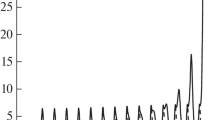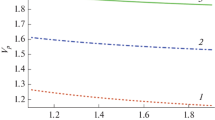Abstract
The influence of electron-ion collisions on breaking cylindrical nonlinear plasma oscillations is studied. Numerical calculations by the particle method and an analytic analysis by the perturbation method in the weak nonlinearity regime show that, with an increasing collision frequency, the time needed to break plasma oscillations increases. The threshold value of the collision frequency is found exceeding which the density singularity does not arise. In this case, the maximum of the electron density formed outside the axis of the oscillations, the growth of which in the regime of rare collisions leads to the breaking effect, after some growth begins to decrease due to the damping of the oscillations.




Similar content being viewed by others
REFERENCES
R. C. Davidson, Methods in Nonlinear Plasma Theory (Academic, New, York, London, 1972).
Ya. B. Zeldovich and A. D. Myshkis, Elements of Mathematical Physics (Nauka, Moscow, 1973) [in Russian].
A. I. Akhiezer and R. V. Polovin, “Theory of wave motion of an electron plasma,” Sov. Phys. JETP 3, 696–705 (1956).
J. M. Dawson, “Nonlinear electron oscillations in a cold plasma,” Phys. Rev. 113, 383–387 (1959).
G. Lehmann, E. W. Laedke, and K. H. Spatschek, “Localized wake-field excitation and relativistic wave-breaking,” Phys. Plasmas 14, 103109 (2007).
L. M. Gorbunov, A. A. Frolov, E. V. Chizhonkov, and N. E. Andreev, “Breaking of nonlinear cylindrical plasma oscillations,” Plasma Phys. Rep. 36, 345–356 (2010).
A. A. Frolov and E. V. Chizhonkov, “Relativistic breaking effect of electron oscillations in a plasma slab,” Vychisl. Metody Programm. 15, 537–548 (2014).
E. Infeld, G. Rowlands, and A. A. Skorupski, “Analytically solvable model of nonlinear oscillations in a cold but viscous and resistive plasma,” Phys. Rev. Lett. 102, 145005 (2009).
P. S. Verma, J. K. Soni, S. Segupta, and P. K. Kaw, “Nonlinear oscillations in a cold dissipative plasma,” Phys. Plasmas 17, 044503 (2010).
A. A. Frolov and E. V. Chizhonkov, “Influence of electron collisions on the breaking of plasma oscillations,” Plasma Phys. Rep. 44, 398–404 (2018).
N. N. Bogoliubov and Yu. A. Mitropolskii, Asymptotic Methods in the Theory of Nonlinear Oscillations (Nauka, Moscow, 1974; Gordon and Breach, London, 1961).
R. W. Hockney and J. W. Eastwood, Computer Simulation Using Particles (McGraw-Hill, New York, 1981).
A. F. Aleksandrov, L. S. Bogdankevich, and A. A. Rukhadze, Principles of Plasma Electrodynamics (Vyssh. Shkola, Moscow, 1978; Springer, Berlin, Heidelberg, 1984).
V. L. Ginzburg and A. A. Rukhadze, Waves in Magnetoactive Plasma (Nauka, Moscow, 1975) [in Russian].
V. P. Silin, Introduction to Kinetic Theory of Gases (Nauka, Moscow, 1971) [in Russian].
V. P. Silin and A. A. Rukhadze, Electromagnetic Properties of Plasma and Plasma-Like Media, 2nd ed. (Librokom, Moscow, 2012) [in Russian].
S. I. Braginskii, “Transport phenomena in plasma,” in Problems of Plasma Theory (Gosatomizdat, Moscow, 1963), pp. 183–285 [in Russian].
B. L. Rozhdestvenskii and N. N. Yanenko, Systems of Quasilinear Equations and Their Applications to Gas Dynamics (Nauka, Moscow, 1968) [in Russian].
E. V. Chizhonkov, “Diagnostics of a gradient catastrophe for a class of quasilinear hyperbolic systems,” Russ. J. Numer. Anal. Math. Model. 32, 13–26 (2017).
N. S. Bakhvalov, A. A. Kornev, and E. V. Chizhonkov, Numerical Methods. Task Solving and Exercises. Classical University Textbook, 2nd ed. (Laboratoriya Znanii, Moscow, 2016) [in Russian].
Author information
Authors and Affiliations
Corresponding author
Additional information
Translated by L. Mosina
Rights and permissions
About this article
Cite this article
Frolov, A.A., Chizhonkov, E.V. The Effect of Electron-Ion Collisions on Breaking Cylindrical Plasma Oscillations. Math Models Comput Simul 11, 438–450 (2019). https://doi.org/10.1134/S2070048219030104
Received:
Published:
Issue Date:
DOI: https://doi.org/10.1134/S2070048219030104




